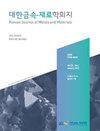共掺杂n型Cu0.008Bi2Te2.6Se0.4多晶合金的电、热、热电输运性质
IF 1.4
4区 材料科学
Q4 MATERIALS SCIENCE, MULTIDISCIPLINARY
引用次数: 1
摘要
Bi2Te3基合金作为接近室温的热电材料已被广泛研究。在本研究中,研究了一系列Co掺杂的n型Cu0.008Bi2Te2.6Se0.4多晶合金(Cu0.008Be2−xCoxTe2.6Se0.4,x=0、0.03、0.06、0.09和0.12)的电学、热学和热电输运特性。在300K下,Cu0.008Bi1.97Co0.03Te2.6Se0.4(x=0.03)样品的电导率与原始Cu0.008Be2Te2.6Se0.4(y=0)样品的793 S/cm相比显著提高了34%,达到1199 S/cm,并且在进一步掺杂后,当x=0.12时,电导率逐渐降低到906 S/cm。与300K时原始Cu0.008Bi2Te2.6Se0.4样品的3.26mW/mK2相比,Co掺杂样品的功率因数降低。同时,Cu0.008Ti1.97Co0.03Te2.6Se0.4(x=0.03)样品的功率因子在520K时变得更高。由于Co掺杂剂的额外点缺陷声子散射,Co掺杂的样品的晶格热导率降低。因此,Cu0.008Bi1.97Co0.03Te2.6Se0.4合金在520 K下的zT为0.83,比原始Cu0.008Be2Te2.6Se0.4的zT大约15%,而Cu掺杂样品在300 K下的zT小于原始Cu0.008 Bi2Te2.6Se0.4样品的zT。通过实验唯象参数,包括态密度、有效质量、加权迁移率和质量因子,分析了Co掺杂Cu0.008Bi2−xCoxTe2.6Se0.4样品的电输运特性。本文章由计算机程序翻译,如有差异,请以英文原文为准。
Electrical, Thermal, and Thermoelectric Transport Properties of Co-Doped n-type Cu0.008Bi2Te2.6Se0.4 Polycrystalline Alloys
Bi2Te3-based alloys have been extensively studied as thermoelectric materials near room temperature. In this study, the electrical, thermal, and thermoelectric transport properties of a series of Co-doped n-type Cu0.008Bi2Te2.6Se0.4 polycrystalline alloys (Cu0.008Bi2−xCoxTe2.6Se0.4, x = 0, 0.03, 0.06, 0.09 and 0.12) are investigated. The electrical conductivity of the Cu0.008Bi1.97Co0.03Te2.6Se0.4 (x = 0.03) sample was significantly enhanced, by 34%, to 1199 S/cm compared to 793 S/cm of the pristine Cu0.008Bi2Te2.6Se0.4 (x = 0) sample at 300 K, and gradually decreased to 906 S/cm for x = 0.12 upon further doping. Power factors of the Co-doped samples decreased compared to the 3.26 mW/mK2 of the pristine Cu0.008Bi2Te2.6Se0.4 sample at 300 K. Meanwhile, the power factor of the Cu0.008Bi1.97Co0.03Te2.6Se0.4 (x = 0.03) sample became higher at 520 K. The lattice thermal conductivities of the Co-doped samples decreased due to additional point defect phonon scattering by the Co dopant. Consequently, the zT for the Cu0.008Bi1.97Co0.03Te2.6Se0.4 alloy at 520 K was 0.83, which is approximately 15% larger than that of pristine Cu0.008Bi2Te2.6Se0.4, while the zT of the Cu doped samples at 300 K was smaller than that of the pristine Cu0.008Bi2Te2.6Se0.4 sample. Electrical transport properties of the Co-doped Cu0.008Bi2−xCoxTe2.6Se0.4 samples were analyzed by experimental phenomenological parameters, including the density-of-state, effective mass, weighted mobility, and quality factor.
求助全文
通过发布文献求助,成功后即可免费获取论文全文。
去求助
来源期刊

Korean Journal of Metals and Materials
MATERIALS SCIENCE, MULTIDISCIPLINARY-METALLURGY & METALLURGICAL ENGINEERING
CiteScore
1.80
自引率
58.30%
发文量
100
审稿时长
4-8 weeks
期刊介绍:
The Korean Journal of Metals and Materials is a representative Korean-language journal of the Korean Institute of Metals and Materials (KIM); it publishes domestic and foreign academic papers related to metals and materials, in abroad range of fields from metals and materials to nano-materials, biomaterials, functional materials, energy materials, and new materials, and its official ISO designation is Korean J. Met. Mater.
 求助内容:
求助内容: 应助结果提醒方式:
应助结果提醒方式:


